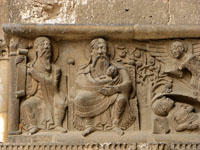| Notes: | "There was a rich man who was dressed in purple and fine linen and who feasted sumptuously every day. And at his gate lay a poor man named Lazarus, covered with sores, who longed to satisfy his hunger with what fell from the rich man's table; even the dogs would come and lick his sores. The poor man died and was carried away by the angels to be with Abraham. The rich man also died and was buried. In Hades, where he was being tormented, he looked up and saw Abraham far away with Lazarus by his side. He called out, 'Father Abraham, have mercy on me, and send Lazarus to dip the tip of his finger in water and cool my tongue; for I am in agony in these flames.' But Abraham said, 'Child, remember that during your lifetime you received your good things, and Lazarus in like manner evil things; but now he is comforted here, and you are in agony. -- Luke 16:19-25 On either side of the entry portal at the medieval abbey church in Moissac, France, "there are complex relief compositions -- on the right, the events of the Incarnation from the Annunciation through the Flight into Egypt; on the left, the vices of Luxuria and Avarice and the parables of the rich fool (Luke 12:16-34) and Dives and Lazarus (Luke 16:19-31). The juxtaposition of the two compositions as parallel components suggests that the later is an allegory of the Last Judgment, balancing the former as the fulfillment of the Incarnation. [from: Romanesque Sculpture: the Revival of Monumental Stone Sculpture in the Eleventh and Twelfth Centuries, by Millard Fillmore Hearn, pg. 174. Lester K. Little in his book, Religious Poverty and the Profit Economy in Medieval Europe (1983, pp. 37-38) notes that the striking imagery of the poor man, Lazarus, and the condemned man, Dives (below Abraham and Lazarus in a section not included in this photograph), reflects the "satirical approach to dealing with the corrosive power of money...in full force by the early twelfth century in the Translation of the Relics of Saints Gold and Silver. This is the story of the Archbishop of Toledo's visit to the papal court in search of a favour. He came laden with relics of the saintly martyrs Albinus and Rufinus (white and red, standing respectively for silver and gold), and at each stage of his progress through the court, he had to produce some of these relics -- kidneys of Albinus, ribs of Rufinus -- in order to get what he wanted. A similar spirit pervades both the roughly contemporaneous Gospel According to the Mark of Silver and a version of the traditional acclamation, "Christ conquers, Christ reigns, Christ rules the world", in which money takes the place of Christ: "Nummus vincit, Nummus regnat, Nummus imperat." " |
|---|

